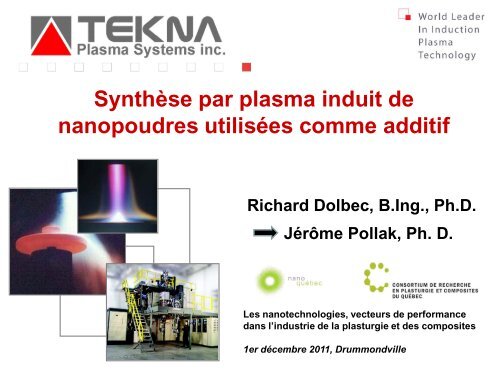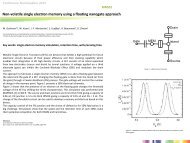5.-tekna.pdf
5.-tekna.pdf
5.-tekna.pdf
You also want an ePaper? Increase the reach of your titles
YUMPU automatically turns print PDFs into web optimized ePapers that Google loves.
Synthèse par plasma induit de<br />
nanopoudres utilisées comme additif<br />
Richard Dolbec, B.Ing., Ph.D.<br />
Jérôme Pollak, Ph. D.<br />
Les nanotechnologies, vecteurs de performance<br />
dans l’industrie de la plasturgie et des composites<br />
1er décembre 2011, Drummondville
Profil de Tekna<br />
• Incorporée 1990<br />
• Située à Sherbrooke, Québec<br />
• 70 employés<br />
• 3 000 m 2<br />
• 2 000 m 2<br />
- Fabrication des équipements<br />
- Recherche et développement<br />
– Nouvelle usine de production de poudres<br />
• 100 systèmes fabriqués à ce jour<br />
– 75% en nanotechnologie (le 1 er en 1998)<br />
• 80% du chiffre d’affaire en vente d’équipements<br />
•Technologie reconnue mondialement<br />
2
Si une nanoparticule de 50 nm avait la taille d’une<br />
rondelle de hockey…<br />
Un virus serait …<br />
Le diamètre d’un<br />
cheveux serait …<br />
Une pièce de<br />
2$ serait …<br />
La distance<br />
Montréal – Québec<br />
équivaudrait à…<br />
… de la taille<br />
d’un homme<br />
…de la hauteur du 1000<br />
de La Gauchetière<br />
…grande comme<br />
l’île de Montréal<br />
…1000 allers-retours<br />
Terre-Lune<br />
3
Variation de la surface spécifique d’un matériau<br />
en fonction de la taille des constituants<br />
Exemple: cube de quartz de 50 kg<br />
NOTE: Les cubes ne sont pas à l’échelle<br />
Materials 3 (2010) pp. 3468-3517<br />
4
Amélioration de la résistance à l’abrasion d’un<br />
revêtement par des nanoparticules d’alumine<br />
Impact mineur sur: brillance, transparence et flexibilité<br />
BYK, Nanotechnology Additives,Technical Information L-NI 1<br />
5
Amélioration de la résistance aux rayons UV d’un<br />
revêtement par des nanoparticules d’oxyde de zinc<br />
Sans impact sur la transparence du revêtement<br />
BYK, Nanotechnology Additives,Technical Information L-NI 1<br />
6
Overview of the World Market of Nanotechnologies<br />
Segmentation of the 2009<br />
nanopowder market by types<br />
2009 rating of nanopowder<br />
producing countries<br />
Source: Abercade Research Company (2009)<br />
SiO 2: 40%<br />
TiO 2: 8%<br />
Al 2O 3: 15%<br />
7
Overview of the World Market of Nanotechnologies<br />
Projected world nano-tech market structure by research area by 2015<br />
Source: Abercade Research Company (2009)<br />
8
Deux approches pour générer des nanoparticules<br />
Approche utilisée<br />
par Tekna<br />
BYK, Nanotechnology Additives,Technical Information L-NI 1,<br />
9
Génération du plasma induit<br />
Powder, liquid suspension, gas<br />
U.S. Patent # 5 200 595 and International PCT/CA92/00156<br />
10
Synthèse de nanopoudres par plasma induit<br />
Precursor<br />
vaporization<br />
zone<br />
Condensation<br />
zone<br />
Radial quench<br />
Nanoparticles<br />
nucleation and growth<br />
Precursor (solid, liquid or gas)<br />
On-axis temperature (K)<br />
0<br />
1000<br />
2000<br />
5000<br />
4000<br />
3000<br />
6000<br />
7000<br />
9000<br />
8000<br />
~10 5 K/s<br />
10000<br />
11
Synthèse de nanopoudres par plasma induit<br />
Unité de synthèse de nanopoudres typique (60kW) commercialisée par Tekna<br />
12
Tekna Matériaux Avancés inc.<br />
La mission de Tekna Matériaux Avancés inc. est de développer et<br />
manufacturer commercialement des matériaux avancés à haute valeur<br />
ajoutée utilisant la technologie de plasma thermique.<br />
Une nouvelle usine a été spécialement conçue par les ingénieurs de<br />
Tekna pour exploiter de façon viable une production commerciale de<br />
matériaux avancés incluant les nanopoudres.<br />
2002<br />
2010<br />
13
Tekna Matériaux Avancés inc.<br />
Systèmes 200 kW pour la production de poudres<br />
14
Examples of nanopowders made at Tekna<br />
and their main applications<br />
- Tin oxide (SnO 2)<br />
- Tungsten sub-oxide (WO x) and bronze (M xWO 3)<br />
- Nickel (Ni)<br />
- Glass<br />
15
• Plasma: Ar/O 2<br />
• BET: 10 m 2 /g<br />
• FE-SEM:<br />
Tin oxide (SnO 2) nanopowder<br />
16
Tin oxide (SnO 2) nanopowder: Application<br />
Used in the electronic industry for making transparent conductive<br />
electrodes in LCD screens:<br />
• Mixed with submicron In 2O 3 powder (90% In 2O 3 + 10% SnO 2)<br />
• Pressed in large targets of 2m x 3m (6’ x 10’) or even more<br />
• Used as target in PVD process for making ITO coatings<br />
• 1: Glass plates (~0.7 mm)<br />
• 2 & 3: Horizontal and vertical polarisers<br />
• 4: RGB colour mask<br />
• 5 & 6: Horizontal and vertical command lines<br />
• 7: Rugged polymer layer<br />
• 8: Spacers<br />
• 9: Thin film transistors<br />
• 10: Front electrode, ITO (100-150 μm)<br />
• 11: Rear electrodes<br />
17<br />
Source: Wikipedia
Tungsten sub-oxide (WO x) nanopowder<br />
• Precursor: Ammonium paratungstate (APT) fine powder<br />
- (NH 4) 10W 12H 2O 42•4H 2O<br />
- Easily available and affordable<br />
- Decomposes at T > 300°C (much lower than boiling point of W = 5555°C)<br />
- 1 kg of APT → 0.7 kg W → 0.88 kg WO 3<br />
•Plasma composition:<br />
Ar/H 2<br />
Ar/He<br />
Ar/O 2<br />
W WO 3<br />
WO x (x < 3)<br />
18
Tungsten bronze (M xWO 3) nanopowders<br />
• Co-feeding of APT with selected alkali metal salt<br />
• Unique advantages of the ICP approach: High level of tunability with respect<br />
to chemical environment, dopant type (M), dopant amount (x), and particle size<br />
M = Na<br />
APT + Na 2CO 3·H 2O<br />
(Na carbonate)<br />
Surf. area: 8.5 m 2 /g<br />
Bronze purity: 97%<br />
M = K<br />
APT + K 2CO 3 (K carbonate)<br />
APT + C 6H 5K 3O 7·H 2O (K citrate)<br />
APT + CH 3CO 2K (K acetate)<br />
Surf. area: 16.5 m 2 /g<br />
Bronze purity: 80%<br />
M = Cs<br />
APT + CsCOOH·H 2O<br />
(Cs formate)<br />
Surf. area: 15 m 2 /g<br />
Bronze purity: 97%<br />
J. Mater. Chem. 20 (2010) 9855<br />
19
Optical properties of M xWO 3 nanopowders<br />
UV-vis-NIR spectra of Na 0.38WO 3, K 0.26WO 3, and Cs 0.2WO 3 nanopowders<br />
visible<br />
NIR<br />
J. Mater. Chem. 20 (2010) 9855<br />
20
Optical properties of M xWO 3 nanopowders<br />
UV-vis-NIR spectra of Cs xWO 3 nanopowders where x = 0.2, 0.25, and 0.3<br />
visible<br />
NIR<br />
J. Mater. Chem. 20 (2010) 9855<br />
21
Applications for M xWO 3 nanopowders<br />
• Interest: good transparency in the visible spectral region (380–700 nm) and<br />
strong absorption in the near infrared (NIR) region<br />
- Clear advantage over carbon black, which is an excellent NIR absorber but its<br />
color is a major drawback for the use in clear coat applications or pale shades<br />
• Heat shielding filters<br />
- Incorporated directly into thermoplastic resins, coatings, inks, or ceramics<br />
• Additive in coatings or thermoplastics for NIR absorption applications<br />
- Promote the curing of clear coats and pigmented systems<br />
→ significantly reduce the energy consumption and curing times<br />
- Heat uptake by M xWO 3 nanoparticles comparable to carbon black<br />
→ For example, only 0.05 wt % M xWO 3 nanoparticles added to a<br />
clear coat can increase processing speed by 2.5 times while<br />
having minimal impact on coloration, haze, or weatherability.<br />
J. Mater. Chem. 20 (2010) 9855<br />
22
• Plasma: Inert gases<br />
• BET: 8 m 2 /g<br />
• O 2 content: 1.2%<br />
→ In-line passivation for<br />
safe powder handling<br />
• FE-SEM:<br />
Nickel (Ni) nanopowder<br />
→ Nanoparticles diameter < 200 nm<br />
23
• Plasma: Ar/O2 • BET: 12 m2 /g<br />
• FE-SEM:<br />
Glass nanopowder<br />
24
Common application for Ni and glass nanopowders<br />
• Multi-layer ceramic capacitors (MLCC)<br />
~ mm<br />
Dielectric layers<br />
Nickel electrodes<br />
Over 500 billion of these tiny capacitors were used worldwide in 2002<br />
Ref.: www.digikey.com; Metal Powder Report 58 (2003) 20;<br />
www.circuitboardpcb.net<br />
25
Conclusion<br />
• La technologie des plasmas induits développée par Tekna :<br />
• Production d'une grande variété de nanopoudres à grande échelle<br />
• Nanopoudres présentant des propriétés spécifiques<br />
• Rendements relativement élevés → prix relativement abordables<br />
• Tekna a la capacité technique et l’intérêt de travailler en collaboration<br />
avec des partenaires industriels pour développer des nanopoudres<br />
pour leurs applications spécifiques.<br />
• Tekna peut développer une nanopoudre pour un partenaire, puis:<br />
• produire la nanopoudre pour le partenaire, ou<br />
• vendre l’équipement et le procédé au partenaire<br />
26






![9. CTMP [Mode de compatibilité]](https://img.yumpu.com/36960283/1/190x146/9-ctmp-mode-de-compatibilitac.jpg?quality=85)




